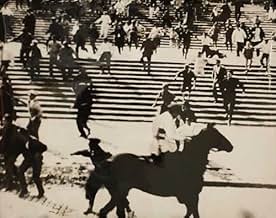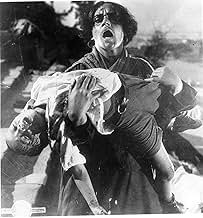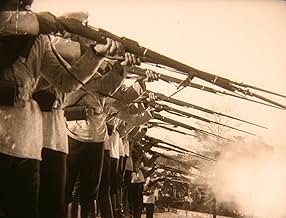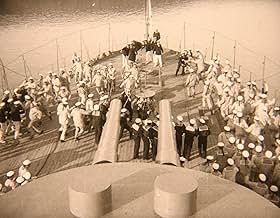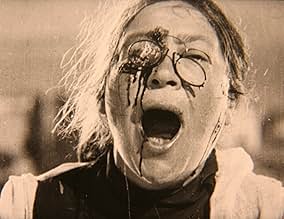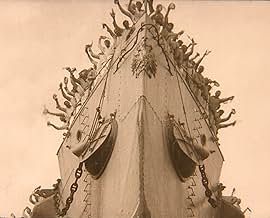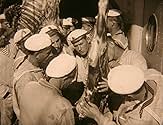IMDb रेटिंग
7.9/10
64 हज़ार
आपकी रेटिंग
1905 की रूसी क्रांति के दौरान, युद्धपोत पोटेमकिन का चालक दल पोत के अधिकारियों के क्रूर, अत्याचारी शासन के खिलाफ विद्रोह करता हैं. ओडेसा में सड़क प्रदर्शन के परिणामस्वरूप पुलिस नरसंहार होता ह... सभी पढ़ें1905 की रूसी क्रांति के दौरान, युद्धपोत पोटेमकिन का चालक दल पोत के अधिकारियों के क्रूर, अत्याचारी शासन के खिलाफ विद्रोह करता हैं. ओडेसा में सड़क प्रदर्शन के परिणामस्वरूप पुलिस नरसंहार होता है.1905 की रूसी क्रांति के दौरान, युद्धपोत पोटेमकिन का चालक दल पोत के अधिकारियों के क्रूर, अत्याचारी शासन के खिलाफ विद्रोह करता हैं. ओडेसा में सड़क प्रदर्शन के परिणामस्वरूप पुलिस नरसंहार होता है.
- पुरस्कार
- कुल 1 जीत
Ivan Bobrov
- Young Sailor Flogged While Sleeping
- (as I. Bobrov)
Nina Poltavtseva
- Woman With Pince-nez
- (as N. Poltavtseva)
Iona Biy-Brodskiy
- Student
- (as Brodsky)
Sergei Eisenstein
- Odessa Citizen
- (as Sergei M. Eisenstein)
Andrey Fayt
- Recruit
- (as A. Fait)
सारांश
Reviewers say 'Battleship Potemkin' is acclaimed for its pioneering montage and editing, significantly impacting cinema. The 1905 Russian Revolution portrayal, especially the Odessa Steps scene, is lauded for its potent visuals and emotional resonance. Many praise its technical innovations and contribution to filmmaking. However, some criticize its political propaganda and shallow character development. Nonetheless, 'Battleship Potemkin' is widely recognized as a cinematic masterpiece and a vital historical film.
फ़ीचर्ड समीक्षाएं
If you're a film student, or were one, or are thinking of becoming one, the name Battleship Potemkin has or will have a resonance. Sergei Eistenstein, like other silent-film pioneers like Griffith (although Eisenstein's innovations are not as commonplace as Griffith's) and Murnau, has had such an impact on the history of cinema it's of course taken for granted. The reason I bring up the film student part is because at some point, whether you'd like it or not, your film professor 9 times out of 10 will show the "Odessa Stairs" sequence of this film. It's hard to say if it's even the 'best' part of the film's several sequences dealing with the (at the time current) times of the Russian revolution. But it does leave the most impact, and it can be seen in many films showcasing suspense, or just plain montage (The Untouchables' climax comes to mind).
Montage, which was not just Eistenstein's knack but also his life's blood early in his career, is often misused in the present cinema, or if not misused then in an improper context for the story. Sometimes montage is used now as just another device to get from point A to point B. Montage was something else for Eisenstein; he was trying to communicate in the most direct way that he could the urgency, the passion(s), and the ultimate tragedies that were in the Russian people at the time and place. Even if one doesn't see all of Eisenstein's narrative or traditional 'story' ideas to have much grounding (Kubrick has said this), one can't deny the power of seeing the ships arriving at the harbor, the people on the stairs, and the soldiers coming at them every which way with guns. Some may find it hard to believe this was done in the 20's; it has that power like the Passion of Joan of Arc to over-pass its time and remain in importance if only in terms of technique and emotion.
Of course, one could go on for books (which have been written hundreds of times over, not the least of which by Eisenstein himself). On the film in and of itself, Battleship Potemkin is really more like a dramatized newsreel than a specific story in a movie. The first segment is also one of the great sequences in film, as a mutiny is plotted against the Captain and other head-ups of a certain Ship. This is detailed almost in a manipulative way, but somehow extremely effective; montage is used here as well, but in spurts of energy that capture the eye. Other times Eisenstein is more content to just let the images speak for themselves, as the soldiers grow weary without food and water. He isn't one of those directors who will try to get all sides to the story; he is, of course, very much early 20th century Russian, but he is nothing else but honest with how he sees his themes and style, and that is what wins over in the end.
Some may want to check it outside of film-school, as the 'Stairs' sequence is like one of those landmarks of severe tragedy on film, displaying the ugly side of revolution. Eisenstein may not be one of the more 'accessible' silent-film directors, but if montage, detail in the frame, non-actors, and Bolshevik themes are your cup of tea, it's truly one of the must sees of a lifetime.
Montage, which was not just Eistenstein's knack but also his life's blood early in his career, is often misused in the present cinema, or if not misused then in an improper context for the story. Sometimes montage is used now as just another device to get from point A to point B. Montage was something else for Eisenstein; he was trying to communicate in the most direct way that he could the urgency, the passion(s), and the ultimate tragedies that were in the Russian people at the time and place. Even if one doesn't see all of Eisenstein's narrative or traditional 'story' ideas to have much grounding (Kubrick has said this), one can't deny the power of seeing the ships arriving at the harbor, the people on the stairs, and the soldiers coming at them every which way with guns. Some may find it hard to believe this was done in the 20's; it has that power like the Passion of Joan of Arc to over-pass its time and remain in importance if only in terms of technique and emotion.
Of course, one could go on for books (which have been written hundreds of times over, not the least of which by Eisenstein himself). On the film in and of itself, Battleship Potemkin is really more like a dramatized newsreel than a specific story in a movie. The first segment is also one of the great sequences in film, as a mutiny is plotted against the Captain and other head-ups of a certain Ship. This is detailed almost in a manipulative way, but somehow extremely effective; montage is used here as well, but in spurts of energy that capture the eye. Other times Eisenstein is more content to just let the images speak for themselves, as the soldiers grow weary without food and water. He isn't one of those directors who will try to get all sides to the story; he is, of course, very much early 20th century Russian, but he is nothing else but honest with how he sees his themes and style, and that is what wins over in the end.
Some may want to check it outside of film-school, as the 'Stairs' sequence is like one of those landmarks of severe tragedy on film, displaying the ugly side of revolution. Eisenstein may not be one of the more 'accessible' silent-film directors, but if montage, detail in the frame, non-actors, and Bolshevik themes are your cup of tea, it's truly one of the must sees of a lifetime.
Sergei Eisenstein's silent masterpiece is a very influential and possibly the most famous landmark film ever made. Many, many memorable scenes, including one of the best and most powerful scenes in film history, the massacre on the Odessa steps. No film in our time has captured such power and amazement from one sequence. Along from being a landmark in film history, it also has a strong message on brotherhood and power hungry leaders. This one has stood the test of time and will for ever more.
There is something special about watching the really old films, especially when it is a film as influential as 'Bronenosets Potyomkin' ('The Battleship Potemkin'). Besides the historical value of the film I was surprised how much I really enjoyed it. Director Sergei Eisenstein takes reel events and changes them a little for this powerful film.
The story begins on the battleship Potemkin where the men are served rotten meat. A sailor named Vakulinchuk (Aleksandr Antonov) steps up and after a series of events mutiny is what follows. Out of revenge an officer is able to kill Vakulinchuk. The men on the ship want to honor him and try to bring their revolution to the shore, to the city of Odessa. They place him in the harbor in a tent with a sign that says he was killed over a boil of soup. The people of Odessa sympathize with the sailors from the Potemkin and they are welcomed in their city. A massacre, in one of the most famous sequences of the cinema, is what follows on the Odessa Staircase.
It is especially this great sequence that shows some real horrors, uncompromising I should add. There are images, like the slit eyeball from 'Un Chien Andalou', you will remember. The people on the staircase, troops firing at them, a crushed hand, a woman with her child shot dead, but most of all a carriage with a baby in it, rolling down the staircase. Every image is effective, showing things what few (or no) films did back then. I was amazed of how good this scene still works today; I was watching in disbelieve.
On a technical scale the film is also very good. Most of the time we believe we are watching what the film wants us to see, the visuals work. Eisenstein is able to make things even more effective the way he cuts between the images. Famous for its montage, 'Bronenosets Potyomkin' sometimes seems like a choreographed sequence of presented images, with a rhythm and a tempo. I could say so much more about this film, one you should have seen if you are interested in the history of the cinema. If you do not really care you might give it a chance. It is one of the most effective silent films I can think of, still very accessible for a large audience.
The story begins on the battleship Potemkin where the men are served rotten meat. A sailor named Vakulinchuk (Aleksandr Antonov) steps up and after a series of events mutiny is what follows. Out of revenge an officer is able to kill Vakulinchuk. The men on the ship want to honor him and try to bring their revolution to the shore, to the city of Odessa. They place him in the harbor in a tent with a sign that says he was killed over a boil of soup. The people of Odessa sympathize with the sailors from the Potemkin and they are welcomed in their city. A massacre, in one of the most famous sequences of the cinema, is what follows on the Odessa Staircase.
It is especially this great sequence that shows some real horrors, uncompromising I should add. There are images, like the slit eyeball from 'Un Chien Andalou', you will remember. The people on the staircase, troops firing at them, a crushed hand, a woman with her child shot dead, but most of all a carriage with a baby in it, rolling down the staircase. Every image is effective, showing things what few (or no) films did back then. I was amazed of how good this scene still works today; I was watching in disbelieve.
On a technical scale the film is also very good. Most of the time we believe we are watching what the film wants us to see, the visuals work. Eisenstein is able to make things even more effective the way he cuts between the images. Famous for its montage, 'Bronenosets Potyomkin' sometimes seems like a choreographed sequence of presented images, with a rhythm and a tempo. I could say so much more about this film, one you should have seen if you are interested in the history of the cinema. If you do not really care you might give it a chance. It is one of the most effective silent films I can think of, still very accessible for a large audience.
An epic of the Russian revolution, Battleship Potemkin, perhaps not so correctly historically, addresses the Russian revolution of 1905. With memorable scenes, especially the flag and the staircase scenes, Russian cinema is perhaps not so shy about showing violence. Which ends up enhancing and giving a more shocking experience when watching the film. A great movie considering the time it was released.
There are only a handful of movies that were made on such a grand scale and made such a difference in the art of movie making.
"Bronenosets Potyomkin" is one of these movies, and it should be on anyone's list looking to learn more about the history of cinema.
Grigori Aleksandrov & Sergei M. Eisenstein directed this groundbreaking film that documents the horrors taking place on a Russian battleship. When the sailors finally retaliate against their superiors, the locals embrace the them, and support them. Things get ugly when a group of soldiers are sent to the small town to take care of business. What follows is one of the most imitated scenes in the history of cinema. Anyone who has seen "The Untouchables", and "Bronenosets Potyomkin" knows exactly what I mean.
Overall I think this movie raised the bar for film making just as "Intolerance" did a few years earlier. If you do not mind silent films, do yourself a favor, and see "Bronenosets Potyomkin".
If you don't like silent films..... watch "Bronenosets Potyomkin" anyway.
"Bronenosets Potyomkin" is one of these movies, and it should be on anyone's list looking to learn more about the history of cinema.
Grigori Aleksandrov & Sergei M. Eisenstein directed this groundbreaking film that documents the horrors taking place on a Russian battleship. When the sailors finally retaliate against their superiors, the locals embrace the them, and support them. Things get ugly when a group of soldiers are sent to the small town to take care of business. What follows is one of the most imitated scenes in the history of cinema. Anyone who has seen "The Untouchables", and "Bronenosets Potyomkin" knows exactly what I mean.
Overall I think this movie raised the bar for film making just as "Intolerance" did a few years earlier. If you do not mind silent films, do yourself a favor, and see "Bronenosets Potyomkin".
If you don't like silent films..... watch "Bronenosets Potyomkin" anyway.
क्या आपको पता है
- ट्रिवियाThe film censorship boards of several countries felt this movie would spread communism. France imposed a ban after a brief run in 1925; it lifted it in 1953 after the death of Russian leader Joseph Stalin. The UK banned it until 1954.
- गूफ़In the Imperial squadron near the end of the film, there are close-ups of triple gun turrets of Gangut-class dreadnought. It possibly was made this way to show the power of Imperial fleet, but battleships of 1905 were much smaller pre-dreadnoughts, with twin turrets only, just like "Potemkin". "Ganguts" entered service in 1914.
- इसके अलावा अन्य वर्जनSergei Eisenstein's premiere version opened with an unattributed quote from Leon Trotsky's "1905": The spirit of mutiny swept the land. A tremendous, mysterious process was taking place in countless hearts: the individual personality became dissolved in the mass, and the mass itself became dissolved in the revolutionary impetus. This quote was removed by Soviet censors in 1934, and replaced by a quotation from V.I. Lenin's "Revolutionary Days": Revolution is war. Of all the wars known in history, it is the only lawful, rightful, just and truly great war...In Russia this war has been declared and won. The original text was restored in 2004.
- कनेक्शनEdited into Seeds of Freedom (1943)
टॉप पसंद
रेटिंग देने के लिए साइन-इन करें और वैयक्तिकृत सुझावों के लिए वॉचलिस्ट करें
- How long is Battleship Potemkin?Alexa द्वारा संचालित
विवरण
- रिलीज़ की तारीख़
- कंट्री ऑफ़ ओरिजिन
- भाषाएं
- इस रूप में भी जाना जाता है
- Battleship Potemkin
- फ़िल्माने की जगहें
- Sevastopol, Crimea, युक्रेन(battleship scenes)
- उत्पादन कंपनी
- IMDbPro पर और कंपनी क्रेडिट देखें
बॉक्स ऑफ़िस
- US और कनाडा में सकल
- $51,198
- US और कनाडा में पहले सप्ताह में कुल कमाई
- $5,641
- 16 जन॰ 2011
- दुनिया भर में सकल
- $62,723
- चलने की अवधि
- 1 घं 15 मि(75 min)
- रंग
- ध्वनि मिश्रण
- पक्ष अनुपात
- 1.33 : 1
इस पेज में योगदान दें
किसी बदलाव का सुझाव दें या अनुपलब्ध कॉन्टेंट जोड़ें


